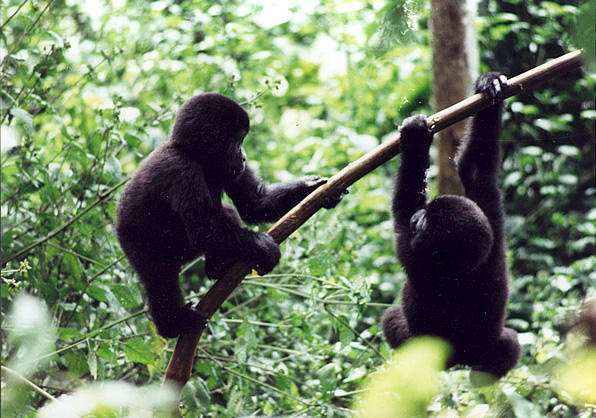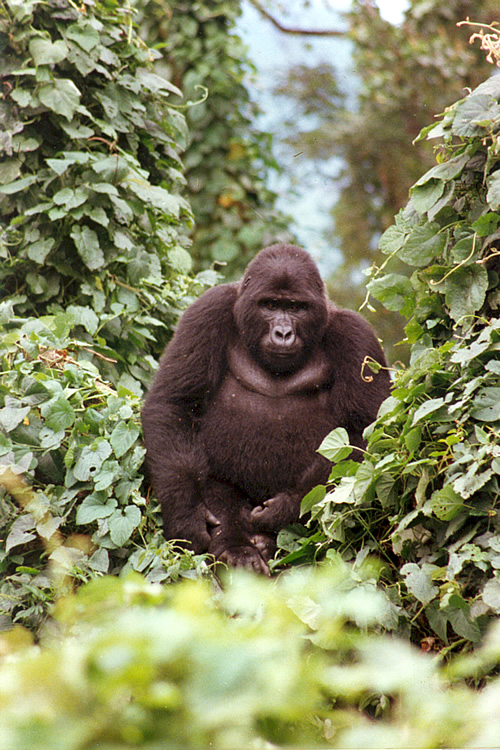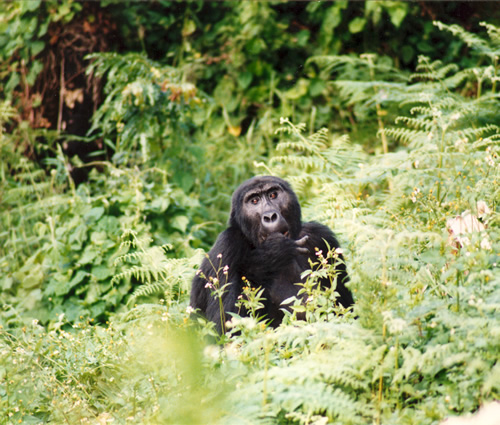Gorilla Conservation in Uganda
Volunteering with the Peace Corps in the Southwest Mountains
Article and photos By Thor Hanson

The forest was dim and quiet and our wet shirts clung to our backs in the heat. Charles Kyomukama, the lead tracker, peered down at the paths of trampled vegetation and wiped sweat from his brow with a handful of crushed leaves.
“Others were feeding here,” he said, pointing at a sapling stripped of its sweet green bark, “but our gorillas have gone up.”
When mountain gorillas have a choice, they always go up. For nearly five hours we had tracked this family of gorillas, cutting our path through the thick tangle of Uganda's Bwindi Impenetrable National Park, still known by its former and more picturesque name, the "Impenetrable Forest."

Nestled among the steep, cultivated hillsides of southwest Uganda, Bwindi Park supports half of the world’s population of 600 endangered mountain gorillas in a remote pocket of lush rainforest. Two of the park’s 23 gorilla families have been habituated to accept daily visits by small tourist groups. Our party included gorilla trackers, a park guide, and six British and American tourists, doggedly pulling themselves up the rugged hillside.
As a Peace Corps volunteer in the Impenetrable Forest Project, I spent two years working with Uganda National Parks and the International Gorilla Conservation Program, a World Wildlife Fund / African Wildlife Foundation project, to help develop tourism in the park (see below). On this warm day in August I was accompanying the tourist group for one of my last visits to the gorillas before returning home to the U. S.
Bwindi is now the most popular park for gorilla tourism. But that wasn’t always the case. American researcher Dian Fossey devoted over 15 years to the study and preservation of mountain gorillas in neighboring Rwanda. Her work, her book (then movie), Gorillas in the Mist, and her still unsolved murder brought international attention to the species.
Gorillas were a major tourist attraction for Rwanda until 1994, when civil war and massive tribal bloodletting left more than 500,000 people dead and millions displaced from their homes. Political instability there and in the neighboring Democratic Republic of Congo (formerly Zaire), made both countries unreliable travel destinations. The turmoil spilled over into Uganda in 1999, when a group of outcast Rwandan rebels attacked Bwindi Park, brutally murdering a warden and several tourists. Since that time heightened security has prevented further incidents and more and more tourists are choosing Ugandan parks for their gorilla tracking adventure.
To many people, Uganda brings to mind its own images of political unrest. Dictator Idi Amin led the country to ruin in the 1970s, committing unspeakable atrocities and acts of genocide against its people. Although less publicized, Uganda’s suffering continued under Amin’s eventual successor, Milton Obote, cementing Uganda’s reputation as a place hardly safe for its own people, let alone foreign tourists. But since Obote’s overthrow in 1985, Uganda has enjoyed nearly two decades of social and economic recovery.
Farmers Confront Gorillas
Topping a rise we came suddenly to the western edge of the forest, a near-straight line separating jungle from cultivation along the Congo border. Thirty miles to the south, the dark, conical peaks of the Virunga Volcanos loomed over the collective boundaries of Uganda, Rwanda, and Congo. There, contiguous national parks in all three countries protect the forest home of the world’s only other population of mountain gorillas, separated from their Bwindi cousins by more than twenty miles of intervening farmland.
Charles looked down the hill, squinting in the sunlight, and shook his head with a rueful smile. “Again they are chewing bananas.”
From our vantage on the hilltop we could see the gorillas clearly. Their dark shapes looked bulky and out of place in the fields, moving slowly among the broad-leaved banana plants. As we made our way down the slope, a farmer called out angrily from above, “Your animals, they are bleeding us! What will we eat now?” One of the trackers went to try to calm the man while we descended to position ourselves near the feeding apes.
Bananas are the only local crop favored by gorillas, but they rarely eat the fruit itself. Instead they go for the watery core of the plant stem. Stands of banana trees near the forest edge may be destroyed before they ever have a chance to bear fruit.
We watched a young silverback (adult male) reach up with one huge arm and pull down a 15-foot tree. The tourists gaped and snapped pictures, but he seemed indifferent to the cameras, glancing our way with calm, intelligent eyes, and scratching absently at the long black fur on his shoulder. Then, with a casual flex and a sideways tear of his teeth, he separated the trunk into ropy strands and began chewing noisily.

The farmer above us continued working, swinging his hoe and turning the black soil for a row of young banana shoots. This convergence of forest, gorillas, and agriculture is a true microcosm of conservation problems in Uganda, where a rapidly growing human population is pressing right up to the edge of protected areas.
Through tourism, conservationists hope to create an economic incentive for preserving mountain gorillas and their habitat. In less than 10 years of operation, Bwindi’s gorilla tourism program has attracted thousands of visitors to Uganda and become the primary income generator for the entire national park system.
Young gorillas command a high price in the illegal pet trade, and poachers often try to capture them alive, killing several protective adults in the process. In spite of improved ranger training and cross-boundary patrols, attacks in recent years have taken the lives of more than a dozen gorillas in Bwindi and the Virungas. An infant confiscated from poachers in 2003 died in captivity before it could be reunited with its family. Many of these killings targeted well-known, habituated gorilla families — a brutal reminder that despite a concerted international effort, the world’s 650 remaining mountain gorillas may still face extinction at the hands of man.
Tourism in Uganda Aids Conservation
Still, there is reason to be hopeful. A positive lesson can be learned from Volcanos National Park (Parc National des Volcans) in neighboring Rwanda, on whose forested slopes Fossey did much of her work. Park patrols, tourism and research activities were all suspended during the recent civil war, but the gorillas and the forest survived the conflict relatively unscathed. In spite of the chaos, with battles fought inside the forest in 1990s and thousands of refugees fleeing through the area, the park boundaries remain intact and only two gorillas were lost. Habitat continues to be damaged by refugee camps in neighboring Congo, but both sides of the Rwandan conflict seemed to recognize the economic potential of gorilla tourism, which had once been the country’s third highest generator of foreign exchange.
Uganda’s tourism project hopes that bringing in revenues similar to Rwanda before its civil war will make its own gorillas a high government priority. Additionally, several international organizations are cooperating with local authorities to spread conservation education, agroforestry, and family planning information to communities surrounding the park. Their integrated program is designed to help reduce the overall human pressures on the forest. The World Bank is also involved.
Towering pillars of cloud loomed above the forest as the final minutes of our visit slipped by. Kasigazi was still feeding high overhead and Katome had returned into the open, resting on his back with one leg flung upwards like another dark trunk in the shade.
“That was the fastest hour of my life,” someone whispered as we slowly backed away and began climbing through the fields. Time with the gorillas is strictly limited to minimize disturbing their natural behavior, but everyone was still ecstatic, wide-eyed, and smiling when we paused to rest on the hilltop.
One of our group wanted to photograph the man planting bananas, but he turned away with a frown and stalked off across the field. To farmers living at the forest edge, tourism and foreign exchange mean nothing when gorillas destroy the crops they need to feed their families. Governments can dictate policy, but local people are the ultimate stewards of the forest, and gaining their support is vital for the long-term protection of mountain gorillas.
Bwindi Park has experimented with revenue-sharing programs designed to distribute a portion of tourism income among surrounding villages. Profits from a community-managed campground have already been used to assist a local school, medical clinic, and women’s club. Funds are now available to compensate farmers for their damaged crops, and a “multiple use” program allows for certain, low-impact activities like beekeeping and the collection of medicinal herbs in designated areas of the forest.
These measures should help people like the angry banana farmer associate gorillas and forest conservation with a tangible increase in their standard of living. Only when governments and local communities together perceive the forest as an asset will there be real hope for the long-term preservation of mountain gorillas.
Heavy tropical raindrops spattered against the greenery and we hurriedly donned our jackets for the long hike back to camp. Suddenly the trackers motioned for silence and pointed down the hillside. Far below us, the gorillas were returning to the forest. They walked hunched forward on their knuckles in a single-file line, ponderous black shadows in the drizzle. Mugurusi, the lead silverback, stopped at the forest edge and seemed to look in our direction while his family slowly crossed the clearing behind him and disappeared, one by one, into a wall of green.
Visiting Mountain Gorillas
The easiest way to visit Uganda’s mountain gorillas is to go with an organized tour group. Abercrombie and Kent offers trips departing from Entebbe that include two days of gorilla tracking at Bwindi. Mountain Travel — Sobek offers a longer trip. Both companies recommend booking 8-12 months in advance due to the limited number of tracking permits available.
Independent travelers should contact Uganda National Park headquarters in Kampala to pre-book a gorilla tracking permit two to three months in advance. Permits cost roughly $250 per person, with a maximum of six people in a group. Stand-by permits are sometimes available at the park itself, but you should be prepared to wait for several days. (Stand-by travelers should also inquire about Mgahinga National Park, where a habituated group is often available for tracking when it crosses into Uganda from Zaire.)
Transportation from Kampala to Bwindi Park can be difficult, so allow for two full days on the road before the date of your tracking permit. Four-wheel drive rental cars are available in Kampala, or catch one of the buses departing from the main bus station at 8 a.m. daily for the 8-12 hour ride to the town of Butagota, ten miles from the park. From Butagota it is a 4-hour hike to the park entrance at Buhoma, where accomodations and camping are available. Private cars can sometimes be hired from Butagota. Be prepared to bargain.
American citizens do not require a visa to visit Uganda, but a yellow fever inoculation is mandatory and malaria prophalaxys are recommended. Contact your public health authorities for details.
Tourism revenues help support gorilla conservation in Ugandan parks, but assistance is needed to preserve habitat and stop poaching throughout their range. To contribute directly to The International Gorilla Conservation Program, contact the African Wildlife Foundation or the World Wildlife Fund.
|
THOR HANSON is a conservation biologist and author of The Impenetrable Forest, an account of his work with Uganda’s endangered mountain gorillas.
|
